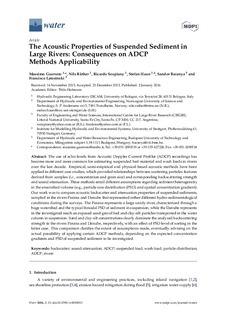| dc.contributor.author | Guerrero, Massimo | |
| dc.contributor.author | Ruther, Nils | |
| dc.contributor.author | Szupiany, Ricardo | |
| dc.contributor.author | Haun, Stefan | |
| dc.contributor.author | Baranya, Sandor | |
| dc.contributor.author | Latosinski, Francisco | |
| dc.date.accessioned | 2020-03-05T12:48:06Z | |
| dc.date.available | 2020-03-05T12:48:06Z | |
| dc.date.created | 2016-06-14T13:11:11Z | |
| dc.date.issued | 2016 | |
| dc.identifier.citation | Water. 2016, 8 (1), . | nb_NO |
| dc.identifier.issn | 2073-4441 | |
| dc.identifier.uri | http://hdl.handle.net/11250/2645513 | |
| dc.description.abstract | The use of echo-levels from Acoustic Doppler Current Profiler (ADCP) recordings has become more and more common for estimating suspended bed-material and wash loads in rivers over the last decade. Empirical, semi-empirical and physical-based acoustic methods have been applied in different case studies, which provided relationships between scattering particles features derived from samples (i.e., concentration and grain size) and corresponding backscattering strength and sound attenuation. These methods entail different assumptions regarding sediment heterogeneity in the ensonified volume (e.g., particle size distribution (PSD) and spatial concentration gradient). Our work was to compare acoustic backscatter and attenuation properties of suspended sediments, sampled in the rivers Parana and Danube that represented rather different hydro-sedimentological conditions during the surveys. The Parana represents a large sandy river, characterized through a huge watershed and the typical bimodal PSD of sediment in suspension, while the Danube represents in the investigated reach an exposed sand-gravel bed and clay-silt particles transported in the water column in suspension. Sand and clay-silt concentrations clearly dominate the analyzed backscattering strength in the rivers Parana and Danube, respectively, with an effect of PSD level of sorting in the latter case. This comparison clarifies the extent of assumptions made, eventually advising on the actual possibility of applying certain ADCP methods, depending on the expected concentration gradients and PSD of suspended sediment to be investigated. | nb_NO |
| dc.language.iso | eng | nb_NO |
| dc.publisher | MDPI | nb_NO |
| dc.rights | Navngivelse 4.0 Internasjonal | * |
| dc.rights.uri | http://creativecommons.org/licenses/by/4.0/deed.no | * |
| dc.title | The acoustic properties of suspended sediment in large rivers: Consequences on ADCP methods applicability | nb_NO |
| dc.type | Journal article | nb_NO |
| dc.type | Peer reviewed | nb_NO |
| dc.description.version | publishedVersion | nb_NO |
| dc.source.pagenumber | 22 | nb_NO |
| dc.source.volume | 8 | nb_NO |
| dc.source.journal | Water | nb_NO |
| dc.source.issue | 1 | nb_NO |
| dc.identifier.doi | 10.3390/w8010013 | |
| dc.identifier.cristin | 1361424 | |
| dc.description.localcode | ©2016 by the authors; licensee MDPI, Basel, Switzerland. This article is an open accessarticle distributed under the terms and conditions of the Creative Commons by Attribution(CC-BY) license (http://creativecommons.org/licenses/by/4.0/). | nb_NO |
| cristin.unitcode | 194,64,91,0 | |
| cristin.unitname | Institutt for bygg- og miljøteknikk | |
| cristin.ispublished | true | |
| cristin.fulltext | original | |
| cristin.qualitycode | 1 | |

